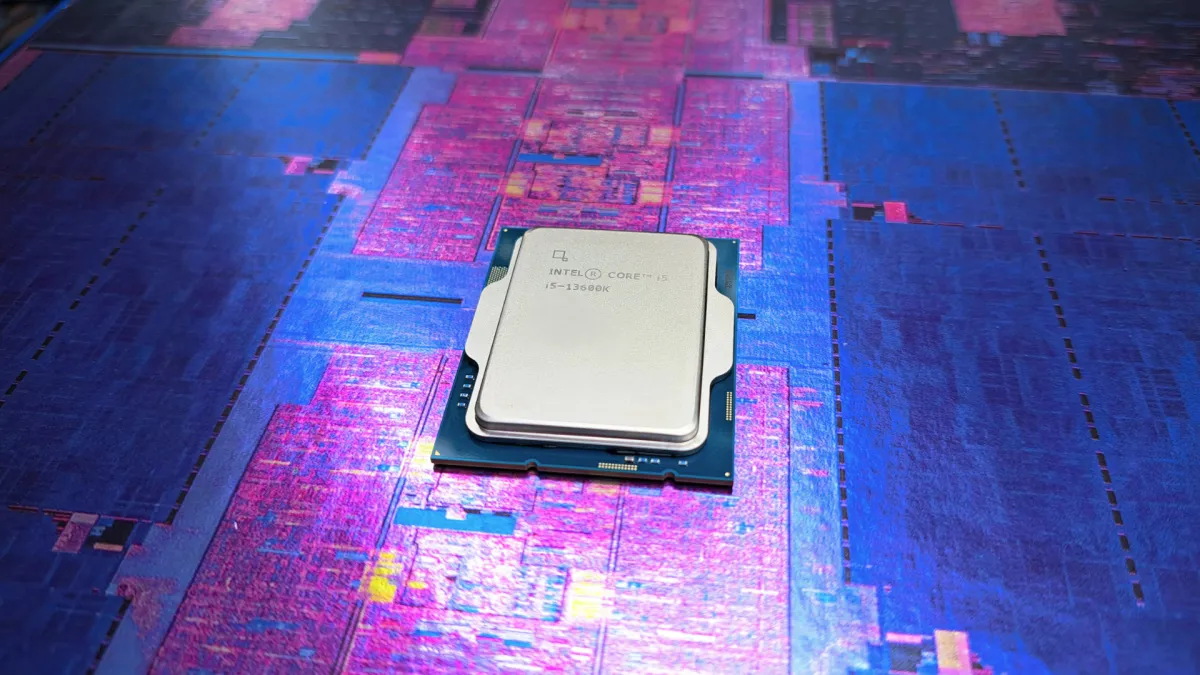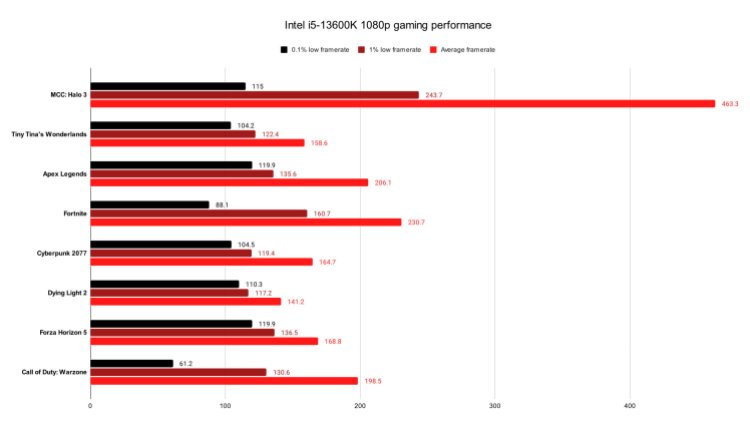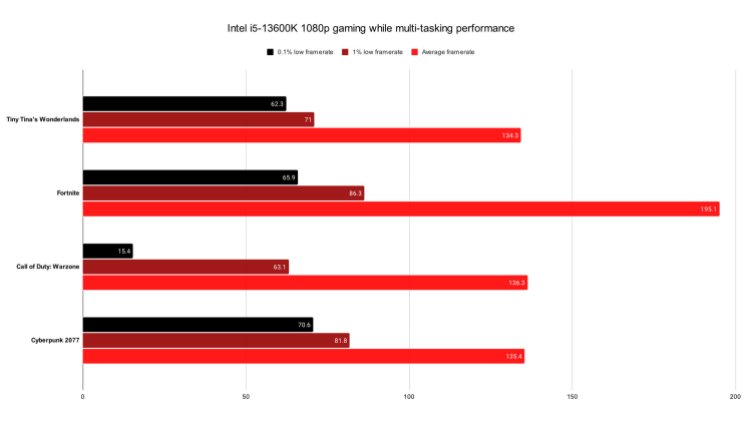Gaming performance and multi-tasking
We collected some benchmarks while simply gaming in popular titles and also ran some tests to show what your framerates will look like while “multi-tasking” so you can see how doing something such as encoding video for a livestream affects your framerates. We collected data from eight games for this review using high settings. We chose to focus most of our tests on DirectX 12 games to fully utilize the P-Cores.
We’re still in the process of building out a proper comparison suite against other CPUs, so the data we’re presenting in this review is limited. We’ll revisit Intel’s 12th gen i5 and i9 K CPUs in soon-to-come content to show you how all of the framerates compare directly. For now, we’ve included the following benchmarks with average framerates, 1% low averages and 0.1% low averages as well to show what the 13600K is capable of. We’ve also included test conditions for each game, and our concluding thoughts on the gaming performance of the 13600K.
Gaming performance
Here’s a look at the gaming performance of the 13600K across various popular titles.
Testing the i-13600K has been an interesting experience with understanding how it scales performance across multiple hardware configurations. In pairing with the 3070 Ti, the 13600K manages the same results as a 13900K in some games and ties the 12600K in others. We also looked for patterns such as how it scales on older games and across different APIs.
Moving to a more powerful GPU, the differences are more clear cut. It scales higher frames it most cases, demonstrating it is a CPU best paired with high-end hardware with an RTX 3080 being the minimum recommendation. As previously noted, we’ll publish more content soon which provides generational comparisons and additional tests on a more powerful configuration to get the full picture.
It’s easy to recommend the 13600K over the 12600K though despite these inconsistencies on the 3070 Ti. Games generally feel more responsive, with a few titles such as Destiny 2 and Fortnite feeling particularly better. This translates to smoother quick-scoping, flick shots, and more consistent framerates to ensure you can perform at your best in multiplayer.
A few titles such as Call of Duty: Warzone did perform worse than the 12600K, but most games produce more frames when paired with the 13600K. The margins of regression lessened when we retested on low settings though, which further reduced the GPU bottleneck and showed the issue lay more with the overall system configuration rather than the CPU itself. If you’re capping your framerates with V-Sync, you’re less likely to see any regressions anyway.
Gaming while multi-tasking
These benchmarks are derived from more extreme workload scenarios than most will likely run, but this provides a look at how performance fairs while capturing gameplay and stressing the CPU.
We only gathered data in four games via the multi-tasking test this time around: Call of Duty: Warzone, Tiny Tina’s Wonderlands, Cyberpunk 2077, and Fortnite. The 13600K handled better than the 12600K, largely in the 1% low category. As you’d expect from a CPU with 14 cores, the 13600K delivered a playable high refresh experience even under these conditions. This makes the 13600K the de-facto choice for anyone looking to get into streaming games without sacrificing their gaming experience or breaking the bank. It also certainly invalidates the need for a dual-PC setup which is a clear step up from CPUs of prior generations from just a couple of years ago.
You will still lose some fps by simultaneously streaming and playing on this CPU, but that may be a limitation of OBS not scaling fully versus the CPU itself not being sufficient for the task. This can also be offset with a better graphics card.
One additional thing we tried was a quick test with Corsair’s Axon hyper-polling feature for its latest gaming mice and keyboards. We set the polling rate to the maximum 8,000Hz setting for the mouse input to see if the 13600K could keep up without dropping framerates. What this does is reduce input lag from the peripherals by nearly a full millisecond at this setting. In previous testing, I was really only able to tell the difference in responsiveness when using the full 8,000Hz setting. For competitive players, this can make a difference in high-stakes situations.
There were still some minor hiccups on the i5 at uncapped framerates, but few and far between. The i9-13900K didn’t have any issues. It’s probably still worth using the full 8,000Hz setting on the 13600K if you don’t play at ultra high refresh rates, and the results were impressive overall for just an i5 CPU.
Game settings used for testing
We’ve included all of the settings we tested with for additional context and for those who wish to reproduce our results. All games were set to 1920×1080 resolution with uncapped framerates. Most settings are on low unless there’s a valid reason for turning the settings up such as player render distances in battle royales. We use the following settings to show how the CPU performs with minimal GPU bottlenecks, but make some exceptions which are noted on a per-game basis. Major settings are as listed:
Halo: The Master Chief Collection – Halo 3 (Steam version)
Play test of one 8v8 matchmaking game (minimum of 10 minutes) and the full Tsavo Highway campaign level, then averaged in-game fps of the two scenarios.
High settings: Enhanced preset.
Tiny Tina’s Wonderlands (Epic Games Store version)
In-game benchmark tool was used for five runs of which the results were then averaged. DX12 API. No resolution upscaler used.
High settings: High preset.
Apex Legends (Steam version)
One hour of gameplay data captured (roughly a full match) during “Hunted” season on World’s Edge map.
High settings: All settings on highest value except Sunspot Shadow detail on medium to stay within VRAM budget.
Fortnite
One hour of gameplay data captured on Chapter 3 Season 4 map (Halloween update). Battle Lab was used and included driving, running, building, fighting bots. DLSS Performance, DX11 API. No internet streaming textures.
High settings: High preset, max render distance, ray tracing off.
Cyberpunk 2077 (GOG version)
We now test with the automated in-game benchmark versus manual testing last year. Our results come from a five run average.
High settings: High preset DLSS Ultra Performance, ray tracing off.
Forza Horizon 5 (Game Pass for PC version)
In-game benchmark tool was used and five back-to-back runs were averaged. Low/normal settings were applied, performed on DX12 API.
High settings: High preset, ray tracing off.
Dying Light 2 (Steam version)
Roughly 20 minutes of gameplay was captured from the first mission up to departing the abandoned compound where you last speak to Spike. DX12 API, DLSS set to Performance.
High settings: High preset, ray tracing off.
Call of Duty: Warzone
One hour of gameplay captured on Caldera Pacific map. DLSS Performance on, DX12 API. No internet streaming textures.
High settings: All settings on highest option or high where Extra or Ultra settings available, ray tracing off.
- Introduction, features, and specs
- Frequencies, power consumption, and temperatures
- Gaming performance and multi-tasking
- Pricing and conclusion









Published: Nov 9, 2022 08:00 am